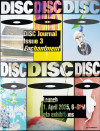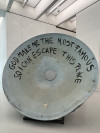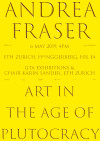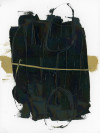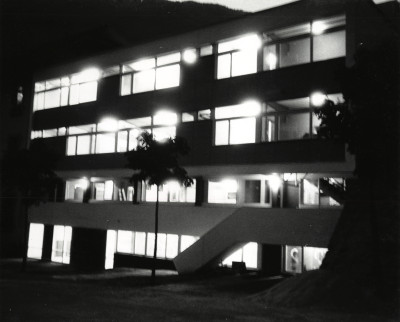
Der Elefant ist der Raum
L’elefante è la stanza
The Elephant is the Room
5 October – 15 November 2024
Opening: 4 October 2024, 6.30 pm
ETH Zurich, Hönggerberg
Symposium: 4 – 5 October 2024
Friday, 4 October 2024, 2 – 5.30 pm, Siemens Auditorium, ETH Zurich, Hönggerberg, HIT E 51
Saturday, 5 October 2024, 10 am – 12.30 pm, gta exhibitions, ETH Zurich, Hönggerberg
Program
Please scroll down for the Italian translation.
Talks and guided tours
1 November, 6.30 – 7.50 pm
Is the elephant still the room? Questions, answers, new questions
With Regina Wecker, Professor Emeritus at the Department of History, University of Basel, Paola De Martin and Melinda Nadj Abonji
11 November, 12.30 – 1.50 pm
Architecture, eugenics and migration ... traversing
With Torsten Lange, architectural historian and lecturer HSLU, Querformat, René Hornung and Philippe Hofstetter, authors of Der Urning: Selbstbewusst schwul vor 1900 (Hier und Jetzt Verlag, 2024), Paola De Martin and Melinda Nadj Abonji
11 November, 6.30 – 7.50 pm
Eugenic violence and countercultures in Switzerland
With Damir Skenderović, Professor of Contemporary History, University of Fribourg, Melinda Nadj Abonji and Paola De Martin
The house of Swiss family policy: how is it built, who built it – and according to which construction plans? Which families are considered worthy of living in this building – and which are not? Who may, must, should and can grow old in it, who can have children and inhabit the house with them – and who cannot? And what does this have to do with migration?
In 1934, a far-reaching law came into force that regulated all these modalities, the Act on the Residence of Foreign Nationals (“Bundesgesetz über Aufenthalt und Niederlassung der Ausländer”, ANAG). The factual rules of the game are quickly summarised: For economic reasons, labour was recruited for a strictly limited period of time; workers were supposed to build and maintain the country’s growing infrastructure for low wages – and without becoming integrated into society. This is the harsh but understandable logic of the labour market. However, if we read the historical context of this law, we are looking into a moral abyss. The ANAG clearly has eugenicist features. For the sake of racial hygiene, it was illegal for immigrants to start a family and reproduce in Switzerland. Their settlement was only permitted as an exception and with great reluctance. The “Fremdarbeiter” (foreign labourers), who were considered particularly fertile and inferior, were seen as a threat to the Swiss national body. A system of rotation and the stigmatising statutes of A (seasonal worker) and B (annual resident) effectively segregated workers from the rest of society and deprived them of the fundamental right to live together with their families. Statutes A and B were a rigorous racist, anti-integrationist, biopolitical measure. From 1934 to 2002, around half a million families from all over southern Europe were traumatised by the violence of these statutes, in some cases severely.
The consequences can still be felt in the third generation. Recent historical research by Paola De Martin and the knowledge stored in the family and body archives of the TESORO association, a human rights organisation that represents the interests of these families, show that those who have suffered from structural violence aimed at preventing them from starting a family in the first place still feel the threatening ghosts of history today. Those affected by the ANAG immigration law and their descendants are confronted with its exclusionary mechanisms and hegemonic power relations when they read certain texts or enter certain rooms – even though the “Saisonnierstatut” (seasonal worker statute) was abolished over two decades ago, in 2002. The history of this “domestic violence” has not become history, but it is not really tangible either. We are currently in a state of collective amnesia.
In 2024 – ninety years after the ANAG came into force – the residue of these historical events will be addressed at ETH Zurich in order to break down this collective amnesia step by step. The symposium and exhibition THE ELEPHANT IS THE ROOM is our attempt to create conditions – for the first time in the country’s history – to facilitate coming to terms with structures that are so deeply ingrained in Switzerland’s unreflected disposition that we can grasp their impact on the present day only by joining forces. It takes courageous collaboration beyond the safe boundaries of our comfort zones if we are to understand the historical and aesthetic dimensions of the architecture of this family policy and the suffering it still causes. THE ELEPHANT IS THE ROOM invites researchers from various disciplines, human rights activists and interested parties from civil society to address these questions together:
How can we trace the suppressed connections between the past and the present, between the migration regime, eugenics and architecture in Switzerland?
How do the latent structures of inequality stored in our immigration laws, co-operative statutes, educational regulations and architectural dogmas manifest themselves in our relationships?
How is this particular form of structural discrimination and privilege stored in border health-control centres, barracks, bachelor houses, garden cities, school buildings, psychiatric institutions, museums, train stations, theatres, universities and hospitals?
What happens to memories when the buildings that housed this violence disappear?
How can research help to defuse their potential to trigger us?
Is this even possible when research itself, its language and its institutions, along with their walls and roofs, are part of the structural violence against migrant families?
The exhibition presents scientific and artistic works produced especially for this occasion, including the video installation "Eugenik und ANAG – Gebildete Handlanger der Macht" by Melinda Nadj Abonji, the talk and zoom lecture "Le Corbusier and Eugenics – It's not a footnote" by Fabiola Lóprez-Durán with Paola De Martin and the textile quotation chamber "Ohne Pro kein Contra – Spaltung und Hierarchie im Schweizer Familienhaus" by Paola De Martin with Melinda Nadj Abonji and Lucia Bernini.
The exhibition also hosts, for the first time in Switzerland, the travelling exhibition by Marius Turda, "'We are not alone': Legacies of Eugenics", which opened at the Wiener Holocaust Library in London in 2021 and then toured the USA, Brazil, Poland, Romania, Sweden, Serbia and the United Kingdom.
The exhibition and symposium were realised by Paola De Martin in collaboration with Melinda Nadj Abonji, Lucia Bernini, the TESORO association, the Chair of the History of Art and Architecture (Prof. Dr. Philip Ursprung) and gta exhibitions. The exhibition is made possible through the kind support of the Swiss National Science Foundation SNSF and Office for Combating Racism (“Fachstelle für Rassismusbekämpfung”, FRB).
Photograph of the border health-control centre in Brig, Heidi and Peter Wenger, 1946-1957, courtesy of EPFL, Lausanne.
_
5 ottobre – 15° novembre 2024
Inaugurazione della mostra: 4 ottobre 2024, ore 18:30
ETH Zürich, Hönggerberg
Simposio: 4 – 5 ottobre 2024
Venerdì, 4 ottobre 2024, 14:00–17:30, Siemens Auditorium, ETH Zürich, Hönggerberg, HIT E 51
Sabato, 5 ottobre 2024, 10:00–12:30, gta Ausstellungen, ETH Zürich, Hönggerberg
Programma
La casa della politica familiare Svizzera, come è costruita? Chi l’ha edificata e secondo quali progetti? Quali famiglie sono considerate degne di vivere in essa e quali no? Chi può, deve, dovrebbe invecchiare al suo interno? Chi può avere figli e figlie e vivere la casa con loro e chi no? E cosa c’entra tutto questo con la migrazione?
Nel 1934 entrò in vigore una legge epocale che ha regolato queste questioni, la Legge federale concernente la dimora e il domicilio degli stranieri (LDDS). Da questa, emergono chiaramente quali fossero le vere regole del gioco, e sono così riassumibili: I lavoratori e le lavoratrici venivano reclutati per un periodo di tempo strettamente limitato e dovevano, mal pagati, costruire e mantenere le sempre più sviluppate infrastrutture del paese, senza però integrarsi. Questa è la logica dura ma comprensibile per il mercato del lavoro. Tuttavia, se si considera il contesto storico in cui questa legge si attua, ci si trova di fronte a un abisso morale. La LDDS ha chiaramente caratteristiche etnico-eugenetiche. Per motivi di igiene razziale, in Svizzera la formazione di nuove famiglie e la riproduzione da parte di migranti erano considerate illegali. Il loro insediarsi era consentito solo in casi eccezionali ed era generalmente indesiderato. Lavoratori e lavoratrici stranieri erano considerati particolarmente fertili e inferiori. Erano visti come una minaccia per l’organismo nazionale svizzero. Attraverso il principio della rotazione e gli Statuti stigmatizzanti A (stagionali) e B (residentiannuali), lavoratori e lavoratrici venivano segregati dal resto della società e privati del diritto fondamentale che garantisce agli esseri umani di vivere insieme alla propria famiglia. Gli Statuti A e B erano una misura biopolitica, anti-integrative e rigorosamente razzista. Dal 1934 al 2002, circa mezzo milione di famiglie proveniente dall’intera Europa meridionale sono state traumatizzate, alcune gravemente, dalla violenza di questa legge.
Le conseguenze sono percepibili fino alla terza generazione. Le più recenti ricerche storiche contemporanee di Paola De Martin e i documenti conservati negli archivi familiari dei membri dell’associazione TESORO – che rappresenta gli interessi di queste famiglie – ci mostrano che: chiunque abbia subito la violenza strutturale usata per impedire la costituzione di nuclei familiari, in questo o in altri contesti in Svizzera, sente ancora oggi i minacciosi fantasmi della storia, soprattutto quando si leggono determinati testi e quando si entra in certe stanze, anche decenni dopo l’abolizione della LDDS, nel 2002. Il ricordo di una remota “violenza domestica” non è scomparso. Ma non è nemmeno realmente tangibile. Siamo in uno stato di amnesia collettiva.
Nel 2024 – novant’anni dopo la promulgazione della LDDS – al Politecnico di Zurigo verrà raccolto l’impulso che emana questa storia, l’impulso a dare inizio ad una graduale dissoluzione di questa amnesia collettiva. Con il simposio L’ELEFANTE È LA STANZA e l’omonima mostra, vorremmo creare le condizioni – per la prima volta nella storia del paese – per fare i conti con strutture che sono profondamente radicate negli atteggiamenti irriflessivi della Svizzera; strutture di cui solo insieme, oggi, possiamo tentare di coglierne il significato. È necessaria una collaborazione coraggiosa, al di là dei confini sicuri delle nostre zone di comfort, se vogliamo comprendere quali dimensioni storiche ed estetiche ha l’architettura di tale politica familiare, ancora così associata a tante sofferenze. L’ELEFANTE È LA STANZA invita ricercatori e ricercatrici di varie discipline, attivisti ed attiviste per i diritti umani e società civile ad affrontare insieme queste domande:
Come possiamo rintracciare le connessioni represse tra passato e presente, tra regimi migratori, eugenetica e architettura in Svizzera?
Come si manifestano, nelle nostre relazioni quotidiane, le strutture latenti di disuguaglianza contenute nelle nostre leggi sull’immigrazione, negli statuti delle cooperative di abitazione, nei regolamenti educativi e nei dogmi architettonici?
In che modo gli edifici sanitari di confine, le baracche, gli “alloggi per scapoli”, le città giardino, gli edifici scolastici, gli istituti psichiatrici, i musei, le stazioni ferroviarie, i teatri, le università e gli ospedali conservano questa particolare forma di discriminazione e di privilegio?
Cosa succede alla memoria quando gli edifici in cui si è manifestata questa violenza scompaiono?
Come possiamo disinnescare il loro potenziale di attivazione del trauma attraverso la ricerca?
Come è possibile tutto ciò quando la ricerca stessa, il suo linguaggio e le sue istituzioni, insieme ai loro muri e soffitti, sono parte della violenza strutturale contro le famiglie migranti?
La mostra presenta opere scientifiche e artistiche prodotte appositamente per l'occasione, tra cui: La videoinstallazione “Eugenik und ANAG – Gebildete Handlanger der Macht” di Melinda Nadj Abonji, la conversazione e conferenza Zoom “Le Corbusier and Eugenics – It's not a footnote” di Fabiola Lóprez-Durán con Paola De Martin, e “Ohne Pro kein Contra – Spaltung und Hierarchie im Schweizer Familienhaus”, la camera di citazione tessile di Paola De Martin con Melinda Nadj Abonji e Lucia Bernini.
La mostra presenta, inoltre, per la prima volta in Svizzera, l'esposizione itinerante di Marius Turda, “‘We are not alone’: Legacies of Eugenics”, inaugurata nel 2021 nella “The Wiener Holocaust Library” a Londra e poi in tournée negli Stati Uniti, in Brasile, Polonia, Romania, Svezia, Serbia e Regno Unito.
La mostra e il simposio sono stati realizzati da Paola De Martin in collaborazione con Melinda Nadj Abonji, Lucia Bernini, l’associazione TESORO, la cattedra di Storia dell’Arte e dell’Architettura (Prof. Dr. Philip Ursprung) e gta Ausstellungen. Con il gentile sostegno del Fondo nazionale svizzero per la ricerca scientifica FNS e del Servizio federale per la lotta al razzismo SLR.
Crediti: foto del centro sanitario di confine a Briga, Heidi e Peter Wenger, 1946–1957, per gentile concessione dell’EPFL di Losanna.
-
Acknowledgements
Many people and groups contributed to the success of the symposium and exhibition THE ELEPHANT IS THE ROOM in their very own way – with their knowledge, their commitment, their experience, their sense of resistant beauty, their linguistic and technical skills. A big thank you to the team play of:
Alessandro Bosco
Anna Jungen
Cenk Akdoganbulut
Daniel Sommer
Ella Bacchetta
Erik Altorfer
Léna Grossenbacher
Leon Weissheimer
Liliana López
Lucia Bernini
Lulzim Kadriu
Fabiola López-Durán
Fredi Fischli
Florian Eitel
Giulia Bernardi
Giorgio Succetti
Jo Baan
Maria A. Satta
Marius Turda
Melinda Nadj Abonji
Mina Hava
Morena La Barba
Nadja Ramsauer
Nando von Arb
Niels Olsen
Nora Refaeil
Oli Wyss
Paola De Martin
Parity Group
Patricia Büttiker
Pascal Germann
Patrick Kury
Peter Ammann
Querformat
Rafi Newman
Regina Wecker
Rodolfo De Martin
Rosa Fratta
Rosa Brux Kollektiv
Philip Ursprung
Sabine Sarwa
Salvatore Bevilacqua
Simon Teuscher
Staff Sozialarchiv
Sreten
Staff Bibliothek ETH
Staff trans Magazin
Teo Schifferli
TESORO
Thomas Huonker
Toni Ricciardi
Torsten Lange
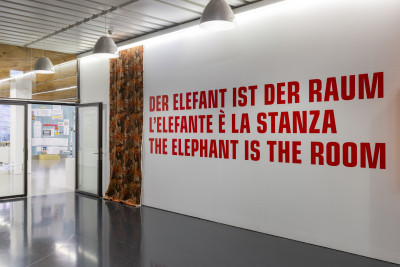
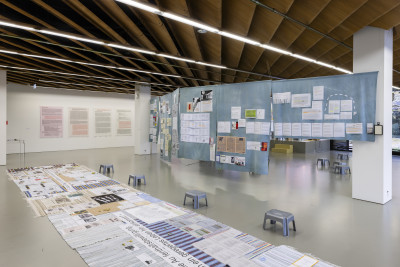
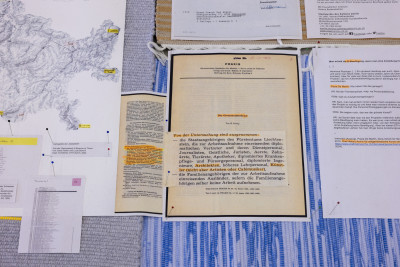
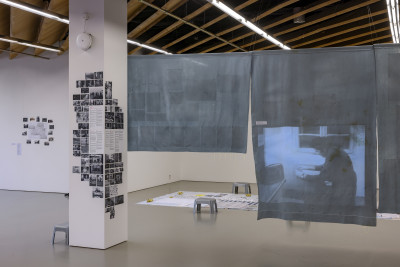
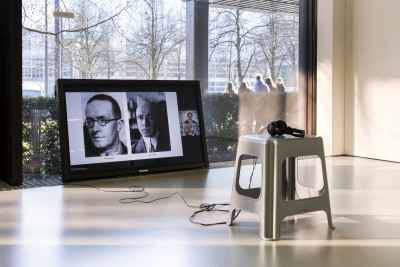


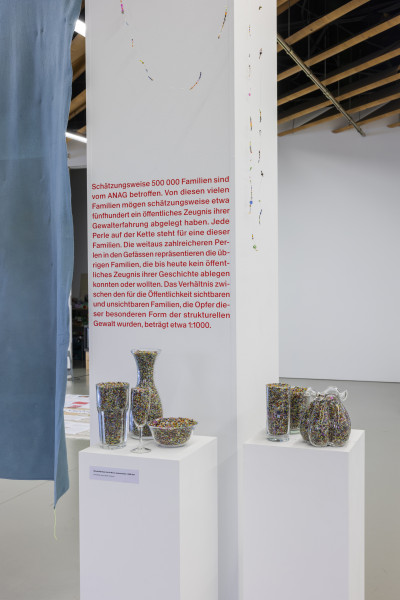

Installation views: Nelly Rodriguez

